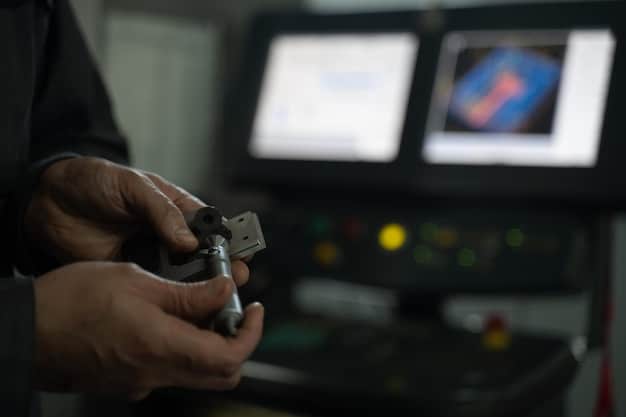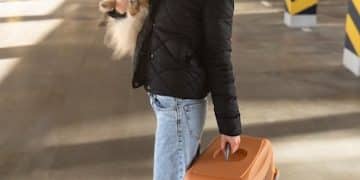New Security Measures at US Airports: A Traveler’s Guide

New security measures at US airports are being implemented to enhance safety and streamline the screening process; travelers should be aware of these changes to ensure a smooth and efficient journey.
Navigating US airports requires staying informed about the latest regulations. New security measures are constantly being implemented to enhance safety and streamline the screening process. Travelers need to be aware of these changes to ensure a smooth and efficient journey. This article provides a comprehensive guide to the new security measures at US airports: what travelers need to know before flying.
Understanding the Evolving Landscape of Airport Security
The landscape of airport security is constantly evolving in response to emerging threats and technological advancements. Staying informed about these changes is crucial for all travelers to ensure a seamless and stress-free experience at US airports. These measures aim to improve overall safety while minimizing inconvenience to passengers.
Why Security Measures Are Constantly Updated
Security protocols are not static; they are continuously updated to address potential vulnerabilities. These updates often incorporate new technologies, revised procedures, and adjustments based on real-time threat assessments. Changes can be influenced by international events, intelligence reports, and ongoing security audits.
The Role of Technology in Modern Airport Security
Technology plays a pivotal role in modern airport security systems. Advanced imaging technology, explosive detection systems, and biometric identification methods are increasingly being deployed to enhance threat detection and passenger screening efficiency. These technologies can scan for prohibited items, verify identities, and analyze passenger behavior to identify potential risks.
- Advanced Imaging Technology (AIT): Utilizes millimeter wave or X-ray backscatter technology to screen passengers for concealed objects.
- Explosive Detection Systems (EDS): Examines luggage and cargo for traces of explosives.
- Biometric Identification: Employs facial recognition and fingerprint scanning for identity verification.
Understanding the rationale and technology behind these security updates can ease concerns and improve traveler cooperation. It also underscores the proactive efforts of airport authorities to maintain a secure environment for all.

TSA PreCheck and Global Entry: Expedited Screening Programs
For frequent travelers, expedited screening programs like TSA PreCheck and Global Entry can significantly reduce wait times and streamline the airport security process. These programs offer a trusted traveler status, granting access to faster security lanes and reduced screening requirements. Understanding their benefits and enrollment procedures is essential for maximizing convenience.
Benefits of TSA PreCheck
TSA PreCheck allows eligible travelers to go through security checkpoints without removing shoes, belts, or light outerwear. Laptops and compliant liquids can also remain in carry-on bags. This accelerated screening process saves time and reduces physical discomfort during security checks.
Exploring Global Entry Advantages
Global Entry provides expedited customs and immigration clearance for pre-approved, low-risk travelers arriving in the United States. Members can use automated kiosks at airports to expedite their entry, reducing wait times and paperwork. Global Entry also includes TSA PreCheck benefits, making it a comprehensive option for international travelers.
- Reduced Wait Times: Enjoy shorter lines at security checkpoints and customs.
- No Shoe or Belt Removal: Expedite screening by keeping shoes and belts on.
- Automated Kiosks: Use kiosks for faster customs clearance upon arrival.
Enrolling in these programs requires an application, background check, and in-person interview. Despite the initial investment of time and fees, the long-term benefits of expedited screening make these programs highly valuable for frequent flyers.
Carry-On Restrictions and Packing Guidelines
Adhering to carry-on restrictions and packing guidelines is fundamental to ensuring a smooth security experience. Understanding what items are permitted, prohibited, and subject to specific regulations can prevent delays and potential confiscation of belongings. Familiarizing yourself with these rules before packing is essential.
Permitted and Prohibited Items in Carry-Ons
The TSA publishes a list of permitted and prohibited items on its website. Common permitted items include liquids in travel-sized containers (3.4 ounces or less), laptops, and medications. Prohibited items typically include firearms, explosives, and sharp objects exceeding specific size limits.
Navigating Liquid Restrictions
The 3-1-1 liquids rule limits the quantity of liquids, gels, and aerosols that can be carried in hand luggage. Each item must be in a travel-sized container of 3.4 ounces (100 milliliters) or less, all placed in a single, quart-sized, clear plastic zip-top bag. This rule applies to most liquid substances, including toiletries and beverages.

Staying updated on these regulations, particularly concerning liquids, can significantly reduce hassles at security checkpoints. Compliance with these guidelines demonstrates preparedness and helps facilitate the screening process.
The Screening Process: What to Expect at the Checkpoint
Understanding the airport security screening process can alleviate anxiety and streamline the experience. From initial identification checks to physical screenings and item inspections, knowing what to expect can make the process less stressful and more efficient. Preparation is key to navigating the checkpoint smoothly.
ID Verification and Boarding Pass Scans
The initial step involves presenting a valid government-issued photo ID and boarding pass to a TSA officer. Acceptable forms of identification include driver’s licenses, passports, and permanent resident cards. The officer verifies the passenger’s identity and confirms their flight information.
Body Scanners and Metal Detectors
Passengers typically pass through either a body scanner (Advanced Imaging Technology) or a metal detector. Body scanners detect concealed objects under clothing, while metal detectors identify metallic items. Individuals may be randomly selected for additional screening or pat-downs if anomalies are detected.
- Body Scanners: Step into the scanner with arms raised; the machine scans for hidden objects.
- Metal Detectors: Remove metallic items from your pockets before walking through.
- Pat-Downs: Conducted by a TSA officer of the same gender if further inspection is needed.
Remaining calm and cooperative throughout the process can expedite screening. Following instructions and answering questions truthfully can help ensure a smooth and efficient experience at the security checkpoint.
Dealing with Special Circumstances
Travelers with disabilities, medical conditions, or unique needs may require additional assistance or accommodation during airport security screening. Understanding how to navigate these special circumstances and what resources are available is essential for ensuring a comfortable and dignified experience. Proactive communication with TSA officers can help address individual needs effectively.
Travelers with Disabilities or Medical Conditions
Travelers with disabilities or medical conditions are encouraged to inform TSA officers about their specific needs. TSA Cares, a helpline, provides assistance and information to travelers with disabilities and medical conditions. Passengers can request private screenings, modified procedures, and assistance with mobility devices.
Traveling with Medications
While medications are generally permitted, it’s advisable to carry them in their original packaging or with a prescription. Inform TSA officers about medications and medical devices during screening. Liquid medications exceeding 3.4 ounces are allowed but may require additional screening.
Preparation and open communication can significantly enhance the travel experience for individuals with special circumstances. Knowing one’s rights and available resources empowers travelers to navigate airport security with confidence and dignity.
Future Trends in Airport Security
The future of airport security is poised to embrace further technological advancements, enhanced data analytics, and increasingly personalized screening processes. These trends promise to improve efficiency, reduce wait times, and enhance overall security effectiveness. Staying abreast of these developments can prepare travelers for future changes.
The Rise of Biometrics and Facial Recognition
Biometric technologies, particularly facial recognition, are becoming increasingly prevalent in airport security. These systems can streamline identity verification, enhance passenger tracking, and improve threat detection capabilities. Facial recognition can reduce reliance on physical identification documents and expedite various airport processes.
Artificial Intelligence and Threat Detection
Artificial intelligence (AI) is playing a growing role in threat detection. AI algorithms can analyze vast amounts of data to identify potential security threats, predict passenger behavior, and optimize security protocols. AI-powered systems can enhance the accuracy and efficiency of screening processes, reducing false positives and improving overall security.
The future of airport security emphasizes a seamless integration of technology and enhanced intelligence to provide a safer and more efficient travel experience. Adaptability and awareness of these trends are key to navigating evolving security landscapes.
| Key Point | Brief Description |
|---|---|
| ✈️ TSA PreCheck | Expedited screening program for eligible travelers. |
| 🧳 Carry-On Restrictions | Follow guidelines on permitted and prohibited items to avoid delays. |
| 🛂 ID Verification | Have a valid government-issued photo ID and boarding pass ready. |
| 🩻 Body Scanners | Be prepared to pass through body scanners or metal detectors. |
FAQ
▼
TSA PreCheck is an expedited security screening program that allows low-risk travelers to experience a faster security process at US airports. Enrolled members do not need to remove shoes, belts, or light jackets.
▼
The 3-1-1 rule limits the quantity of liquids in carry-ons. Each liquid must be in a 3.4-ounce container, all placed in a single, quart-sized, clear plastic zip-top bag. This facilitates easier inspection.
▼
Yes, medications are generally permitted. It’s advisable to carry prescriptions and inform TSA officers about any medical devices. Liquid medications over 3.4 ounces are also allowed but may require additional screening.
▼
Travelers with disabilities or medical conditions should inform TSA officers about their needs. TSA Cares provides assistance, and accommodations like private screenings and modified procedures can be requested to ensure comfort and dignity.
▼
A valid government-issued photo ID, such as a driver’s license, passport, or permanent resident card, is required at airport security. The ID must match the name on the boarding pass for verification.
Conclusion
Staying informed about the latest security measures at US airports is essential for a smooth and efficient travel experience. By understanding evolving security protocols, enrolling in expedited screening programs, and adhering to packing guidelines, travelers can navigate airport security with confidence and ease. Preparation, awareness, and cooperation are key to ensuring a stress-free journey through US airports.





